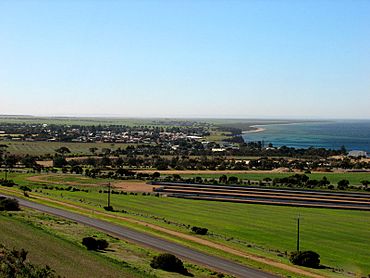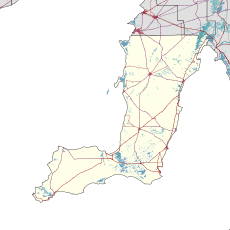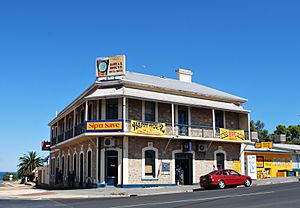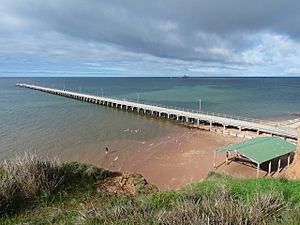Ardrossan, South Australia facts for kids
Quick facts for kids ArdrossanSouth Australia |
|||||||||||||||
|---|---|---|---|---|---|---|---|---|---|---|---|---|---|---|---|

Ardrossan and coastline viewed from a lookout
|
|||||||||||||||
| Established | 1873 | ||||||||||||||
| Postcode(s) | 5571 | ||||||||||||||
| Elevation | 23 m (75 ft) | ||||||||||||||
| Location | 149 km (93 mi) North West of Adelaide via |
||||||||||||||
| LGA(s) | Yorke Peninsula Council | ||||||||||||||
| State electorate(s) | Narungga | ||||||||||||||
| Federal Division(s) | Grey | ||||||||||||||
|
|||||||||||||||
|
|||||||||||||||
| Footnotes | Climate Adjoining localities |
||||||||||||||
Ardrossan is a town in the Australian state of South Australia. It is found on the eastern coast of the Yorke Peninsula. The town is about 150 kilometres (93 miles) by road from the centre of Adelaide.
Ardrossan is well-known for its deepwater shipping port. It also has tall coastal cliffs made of red clay.
Contents
Ardrossan's Story
The Narungga people are the traditional owners of the land where Ardrossan is built. They are Aboriginal Australian people. The Narungga had four main groups, or clans, living across the Yorke Peninsula.
The first European settlers arrived after the British started a colony in South Australia. These early settlers were pastoralists, meaning they raised sheep and cattle. In 1852, William Sharples started a large sheep farm called Parara. The name Parara means "middle" in the Narungga language.
North of Ardrossan, there are natural springs called Tiddy Widdy. These springs were an important source of fresh water for the Narungga people.
In 1873, a new area of land was officially named the Hundred of Cunningham. Soon after, the town of Ardrossan was created on 13 November 1873.
Ardrossan was built in a place once known as Clay Gully. It got its name from Governor Fergusson. He named it after a seaport in Scotland called Ardrossan. Both places have similar tall cliffs and rocky areas.
The town's location was chosen because it was good for shipping. Farmers could easily send their wheat across the Gulf St Vincent to Port Adelaide. A jetty (a pier for ships) was finished in 1877. This jetty was later made longer for bigger steamships and windjammers that carried grain overseas.
By 1878, Ardrossan had grown to include houses, a post office, a flour mill, a church, and a hotel. A public school also opened that year with 53 students.
During the late 1800s and early 1900s, the town grew thanks to the farms nearby. Ardrossan also became famous for Clarence Herbert Smith's factory. From 1880 to 1935, he made the Stump-jump plough there. This special plough was invented in South Australia and helped farmers grow crops in tough, rocky land all over Australia.
Ardrossan in the 20th Century
After the 1930s, Ardrossan stayed much the same size for a while. But in the 1950s, a big open-pit mine opened. This mine, run by BHP, dug up dolomite, a type of rock used to make steel.
A new 1-kilometre (0.62-mile) long jetty was built for the mine. At the same time, large storage silos were built for grain. Today, this "new" jetty is used by ships loading dolomite, grain, and salt. The salt comes from large salt ponds near Price, about 10 kilometres (6.2 miles) away. This wharf can handle very large ships.
How Ardrossan is Run
Ardrossan is part of the Yorke Peninsula Council, which is its local government. For state elections, it is in the electoral district of Narungga. For federal elections, it is in the division of Grey.
Animals and Plants
The coast and waters around Ardrossan are home to many water-fowl, sea birds, and shorebirds. Many waders also visit the area during summer.
Between September and April, you can find many blue swimmer crabs (called Portunus pelagicus) in the waters.
Windara Reef: A Special Underwater Project
Windara Reef is Australia's largest project to bring back oyster reefs. It's also the biggest outside of the United States. The name "Windara" comes from the Narungga name for this area. The reef is about 7 kilometres (4.3 miles) south of Ardrossan, near Rogues Point. It sits about 8 to 10 metres (26 to 33 feet) deep.
Long ago, oyster reefs, mostly made by Australian flat oysters, stretched for 1,500 kilometres (930 miles) along South Australia's coast. But by the 2000s, they had all disappeared. This happened because of too much fishing (especially dredging the sea floor, which destroys oyster beds), water pollution, and diseases.
Many groups worked together on the Windara Reef project. These included the Yorke Peninsula Council, The Nature Conservancy, and the state and federal governments. The first part of the project was finished in June 2017. The second part, adding more reef area, was done in September 2018. More than 7 million young Australian flat oysters were placed on the reef's base.
These native oysters help make the ocean healthier. Adult oysters can filter over 100 litres (26 US gallons) of water each day. They also create a special substance that feeds small shellfish, which then become food for bigger fish. This process helps more fish grow than other types of artificial reefs.
Ardrossan's Economy
Grain farming and raising animals are still very important for Ardrossan's economy.
The dolomite mine and its jetty are now owned and run by a company called Arrium.
Tourism in Ardrossan
Tourism is becoming a bigger part of Ardrossan's economy. Many people from Adelaide visit on weekends. While the town doesn't have a big swimming beach, it's a great spot for fishing and catching blue swimmer crabs. The new Windara Reef is also open for people who fish for fun.
The town's two jetties are also good for scuba diving. They are easy to get into, and you can see lots of marine life.
Shipwrecks Near Ardrossan
About 15 miles (24 kilometres) offshore, there is a historic shipwreck called the Zanoni. This ship sank on 11 February 1867. It was found again on 17 April 1983, after 116 years! It is one of the best-preserved old merchant sailing ships in Australia.
To protect the Zanoni, a special protected area was set up around it in May 1983. Now, you need a permit to go boating or diving near the Zanoni.
To give divers another place to explore, an old barge was sunk on 11 April 1984. This created a new artificial reef about one nautical mile south of the Zanoni wreck. This barge is known as the No. 5 Barge or the Ardrossan Barge.
Oyster Farming and the Blue Economy
The Windara Reef (mentioned above) helps both ecotourism and creates new jobs. This is part of a "blue economy" where people use ocean resources in a sustainable way. However, commercial fishing, anchoring, spearfishing, and taking animals or plants like crabs, oysters, or seaweed from the reef are not allowed.
Climate
Ardrossan has a maritime climate, like most of the Yorke Peninsula. This means summers are warm, and winters are mild. Winter mornings and nights can be cool or cold, and it usually rains more then.
Media
The Ardrossan News was a newspaper briefly printed for the town. It ran from February to July 1911.
Gallery
Notable residents
- Clarence Herbert Smith
- Sam Jacobs, AFL footballer
- Caleb Poulter, AFL footballer









